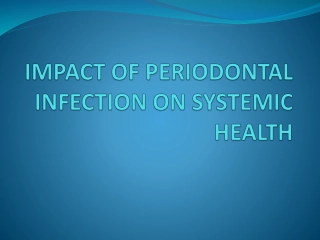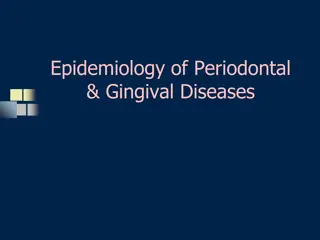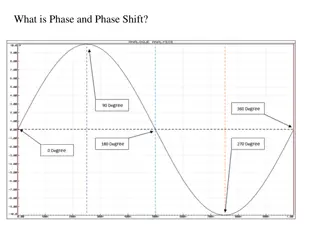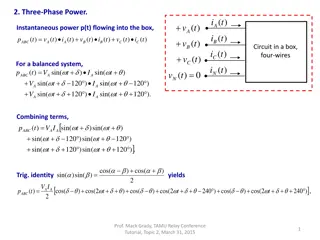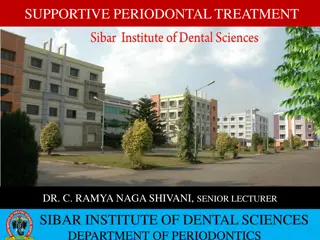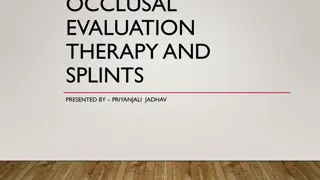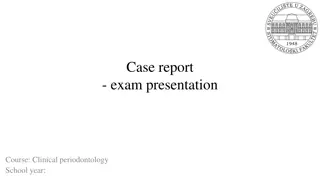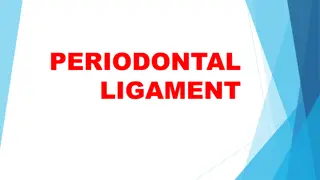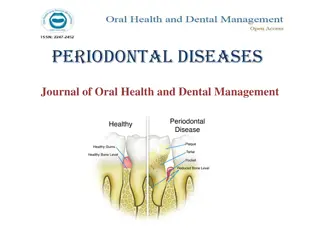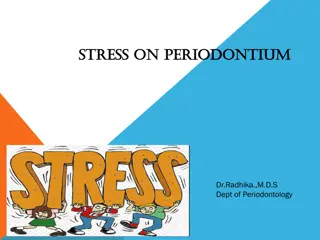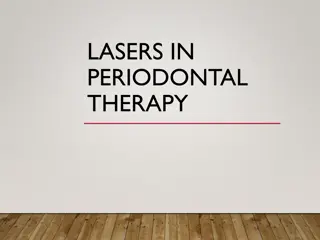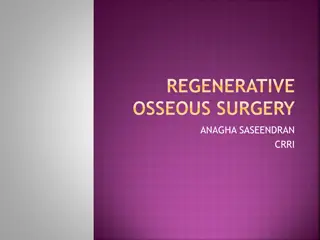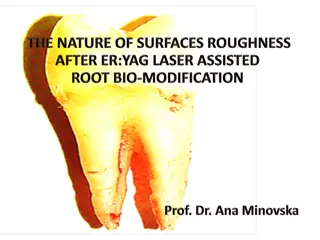Comprehensive Overview of Phase II Periodontal Therapy
Explore the phases, objectives, and treatment methods of Phase II periodontal therapy, including surgical interventions, pocket therapy, and indications for surgery. The treatment plan involves emergency care, nonsurgical therapy, surgical procedures, restorative treatments, and maintenance protocols. Understand the importance of each phase in managing periodontal diseases effectively.
Download Presentation

Please find below an Image/Link to download the presentation.
The content on the website is provided AS IS for your information and personal use only. It may not be sold, licensed, or shared on other websites without obtaining consent from the author.If you encounter any issues during the download, it is possible that the publisher has removed the file from their server.
You are allowed to download the files provided on this website for personal or commercial use, subject to the condition that they are used lawfully. All files are the property of their respective owners.
The content on the website is provided AS IS for your information and personal use only. It may not be sold, licensed, or shared on other websites without obtaining consent from the author.
E N D
Presentation Transcript
Phase II periodontal therapy presented by : Aishwarya kendre
Content Introduction Phases of periodontal therapy Objectives of the sergical Phase Pocket elimination vs pocket reduction Critical zone in pocket sergery Methods of pocket therapy Indication for periodontal sergery
Treatment plan Treatment plan
Phases of periodontal therapy Phases of periodontal therapy Emergency phase Etiotropic phase Sergical Phase Restorative phase Maintenance please Preliminary phase Phase 1 therapy Phase 2 therapy Phase 3 therapy Phase 4 therapy
Preliminary Phase (a) Treatment of emergencies: DentalPeriapicalPeriodontal/Other (b) Extraction of hopeless teeth Nonsurgical Phase (Phase I Therapy) (a) Plaque control and patient education: Diet control, Removal of calculus and root planing, Correction of restorative and prosthetic irritation factors Excavation of caries and restoration, Antimicrobial therapy (local or systemic), Occlusal therapy Minor orthodontic movement, Provisional splinting and prosthesis
Surgical Phase (Phase II Therapy) Emergency phase (a) Periodontal therapy, including placement of implants (b) Endodontic therapy Restorative Phase (Phase III Therapy) Nonsurgical phase (a) Final restorations (b) Fixed and removable prosthodontic appliances (c) Evaluation of response to restorative procedures Maintenance Phase (Phase IV Therapy) Pocket depth and gingival inflammation Plaque and calculus, caries
Introduction Introduction Many modense to advanced cases be read without surgically gaining cow to the out face for not reducing or and pocket depth to allow the paint to remove bafilm The gical phase of therapy is also refimed to as phase II therapy Th chapter describes the surgical techniques used for the following purpose
Controlling or eliminating periodontal disease Correcting conditions that for periodontal disease impair esthetics, or impede placement of prosthetic appliances deepening Placing implants to replace lost teeth and improving the envi ment for their placement and function Many cases are successfully treated and maintained by phase I therapy The chapters in Section V discuss the techniques and concepts used to treat periodontal diseases that require a surgical approach to reduce or eliminate pockets and obtain access to the root surface to remove accretions
Objectives Objectives Improvement of esthetics Improvement of prognosis of the teeth and their replacement. The correction of anatomical and morphological defects that may favor plaque accumulation and pocket recurrenceor impaired esthetics. The purpose of pocket therapy is to eliminate pathological changes in wall.
Procedures Procedures pocket reduction sergery Resective Regenerative Plastic sergery techniques to widen attached gingiva Epithelial graft Connective tissue graft Esthetic sergery Root coverage Recreation of gingival papillae
Advantages Advantages increase accessibility to the root surface ,making it possible to remove all irritants Reduce or eliminate pocket depth ,making it possible for the patients to maintain the root surface free of plaque . Reshape soft and hard tissue to attent a harmonious tomography
Sergical pocket therapy Sergical pocket therapy Surgical pocket therapy can be used to gain access to the disc root surface to ensure the removal of calculus located subging before surgery and to eliminate or reduce the depth of the per tal pocket. Successful periodontal therapy completely eliminates calc plaque or biofilm, and diseased cementum from the tooth sur increases as the pocket becomes deeper. The irregularities and or Numerous investigations have shown that the difficulty
the pocket, which increases the visibility and accessibility of surface. The surgical flap technique allows the clinician to these problems of access to the root surface Pocket elimination is another important consideration. It of reducing the depth of the periodontal pocket to that logic sulcus to enable cleaning by the patient. By proper det, resective and regenerative techniques can be used pish this goal A pocket makes it impossible for the remove biofilm, which is part of the
Result of pocket therapy Result of pocket therapy A periodontal pocket can be in an active state or a period of inactivity or quiescence. In an active pocket, underlying bone is being lost (. It often is diagnosed clinically by bleeding that occurs spontaneously or in response to probing. After phase I therapy, the inflammatory changes in the pocket wall subside, rendering the pocket inactive and reducing its depth (. The extent of this reduction depends on the depth before treatment and the degree to which the depth is the result of the edematous and inflammatory component of the pocket wall (i.e., pseudopocket).
Pocket elimination vs pocket Pocket elimination vs pocket maintenance maintenance Pocket elimination (i.e., depth reduction to gingival sulcus levels) has traditionally been considered a type of periodontal therapy. It was considered vital because of the need to improve access to root surfaces for the therapist during treatment and for the patient after healing. Prevailing opinion considers deep pockets after therapy to represent a greater risk of disease progression than shallow sites.
Longitudinal studies of different therapeutic modalities over the past 30 years have produced conflicting results, probably because of problems created by the split-mouth design. After surgical therapy, pockets that rebound to a shallow or moderate depth can be maintained in a healthy state and without radiographic evidence of advancing bone loss by maintenance visits consisting of scaling and root planing, with oral hygiene reinforcement performed at regular intervals of 3 months or less.
In these patients, the residual pocket can be examined with a thin periodontal probe without pain, exudate, or bleeding. This indicates that biofilm has not formed on the subgingival root surfaces.
Pocket depth remains an important clinical variable in making decisions about treatment. Lindhe and colleagues compared the effect of root planing alone or using a modified Widman flap with the resultant level of attachment and in relation to initial pocket depth.
Re Re- -evaluation after phase I evaluation after phase I therapy therapy Longitudinal studies found that all patients should be treated initially with scaling, root planing, and plaque or biofilm control and that a final decision on the need for periodontal surgery should be made only after a thorough evaluation of the effects of phase I therapy.
Assessment typically is made no less than 1 to 3 months and sometimes as much as 9 months after the completion of phase I therapy . Reevaluation of the periodontal condition includes repeat probing of the entire mouth. Calculus, root caries, defective restorations, and signs of persistent inflammation should also be evaluated.
Critical zone in pocket sergery Critical zone in pocket sergery Criteria for the selection of a surgical technique for pocket therapy are based on clinical findings in the soft tissue pocket wall, tooth surface, underlying bone, and attached gingiva.
1. Soft tissue pocket wall 1. Soft tissue pocket wall
2.Tooth surface 2.Tooth surface The clinician should identify the deposits on and alterations of the cementum surface and determine the accessibility of the root surface to instrumentation. Phase I therapy should have solved many or all of the problems on the tooth surface . Evaluation of the results of phase I therapy can determine the need for further therapy and the method to be used.
3. Underlying bone 3. Underlying bone The clinician should establish the shape and height of the alveolar bone next to the pocket wall through careful probing and clinical and radiographic examinations . The number of osseous walls-one, two, or three- helps to determine whether resective or regenerative therapy can be used Bony craters, horizontal or angular bone losses, and other bone deformities also are important criteria in selection of the treatment technique.
4. Attached gingiva 4. Attached gingiva The clinician should consider the presence or absence of an adequate band of keratinized, attached gingiva when selecting the pocket treatment method. An inadequate attached gingiva can be caused by a high frenum attachment, marked gingival recession, or a deep pocket that reaches the level of the mucogingival junction. All of these conditions should be explored and their influence on pocket therapy considered.
Methods of pocket therapy Methods of pocket therapy The methods for pocket therapy can be classified as follows: 1. New attachment techniques offer the ideal result because they eliminate pocket depth by reuniting the gingiva with the tooth at a position coronal to the bottom of the preexisting pocket. New attachment involves regeneration of bone, connective tissue, periodontal ligament, and cementum
2. Removal of the pocket wall is the most common method. The wall of the pocket consists of soft tissue and can include bone in the case of intrabony pockets. It can be removed by the following methods: Retraction or shrinkage, where plaque or biofilm removal by the patient and scaling and root planing
Retraction or shrinkage, where plaque or biofilm removal by the patient and scaling and root planing resolve the inflammatory process, can occur. The gingival tissue shrinks, reducing the pocket depth. Surgical removal of the pocket is done by gingivectomy or the undisplaced flap technique. Apical displacement of the flap is performed with an apically displaced flap.
Removal of the tooth side of the pocket, which is accomplished by tooth extraction or by partial tooth extraction in the case of furcation involvement (i.e., hemisection
Criteria for selection of method of Criteria for selection of method of sergical therapy sergical therapy Selection of a technique for treating a particular periodontal lesion is based on the following considerations: 1. Characteristics of the pocket: depth, relation to bone, and configuration 2. Accessibility to instrumentation, including furcationinvolvement 3. Existence of mucogingival problems 4. Response to phase I therapy
5. Patient cooperation, including the ability to perform effective oral hygiene and stop smoking 6. Age and general health of the patient 7. Overall diagnosis of the case: various types of gingival enlargement and types of periodontitis (eg, chronic marginal periodontitis, localized aggressive periodontitis, generalized aggressive periodontitis) 8. Esthetic considerations 9. Previous periodontal treatments.
Approaches to specific pocket Approaches to specific pocket problem problem Therapy for gingival pockets Gingival pockets do not have an osseous component (i.e., no attachment loss) and usually have edematous or fibrotic gingival tissue. Two factors are taken into consideration: the character of the pocket wall and the accessibility of the pocket.
The pocket wall can be edematous or fibrotic. Edematous tissue shrinks after the elimination of local factors, reducing or totally eliminating pocket depth. Scaling and root planing is the technique of choice for these cases. Pockets with a fibrotic wall are not appreciably reduced in depth after scaling and root planing. These pockets are eliminated or reduced by sergical therapy
Therapy for incipient periodontitis In patients with slight or incipient periodontitis with minimal . attachment and bone loss, the pocket depths are shallow or a moderate depth. In these patients, the conservative approach of good oral hygiene, scaling, and root planing when necessary usually suffices to control the disease.
Incipient periodontitis that recurs in previously treated sites with good hygiene may require a thorough analysis of the recurrence, which may be caused by remnants of calculus that were missed during previous treatment or other factors such as open margins of a restoration located subgingivally. Occasionally, a surgical approach may be required to correct these problems.
The clinician must explain that the therapy may be a compromise between complete pocket elimination and achieving an esthetic result that is acceptable to the patient. The patient must be educated before therapy that the result may be some degree of gingival recession and some loss of the interdental papilla
The anterior dentition has two advantages for using a conservative (nonsurgical) approach: (1) the teeth are all single rooted and easily accessible for subgingival scaling and root planing, (2) patient compliance and thoroughness in plaque or biofilm control may be easier to attain. Nonsurgical therapy is therefore the technique of choice for the maxillary anterior dentition.
Therapies for moderate to severe Therapies for moderate to severe periodontitis in posterior areas periodontitis in posterior areas Treatment for the maxillary and mandibular premolars and molars does not entail esthetic problems but frequently involves difficult access for root therapy. Bone defects occur more often in the posterior area than the anterior, with many areas having deep infrabony lesions and anatomic root problems with concavities, such as the mesial surface of the maxillary first premolar.
A difficult problem encountered in the posterior area is the furcation lesion. Because this area can pose insurmountable problems for instrumentation unless a flap is reflected, surgery is frequently indicated. Surgery is used in the posterior area for enhanced access


